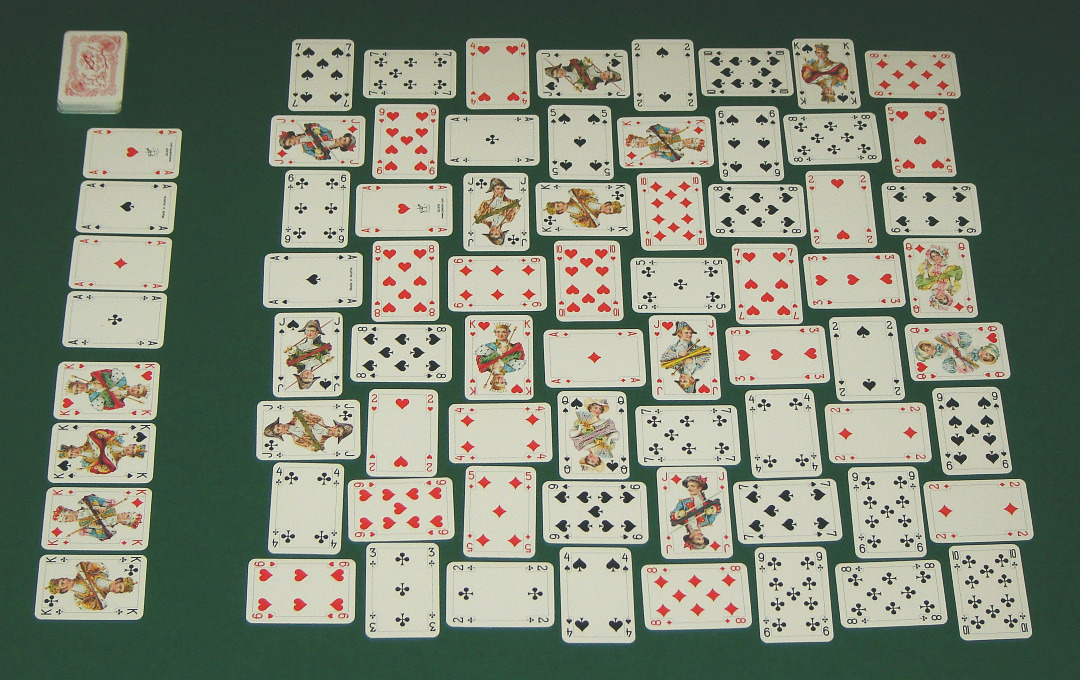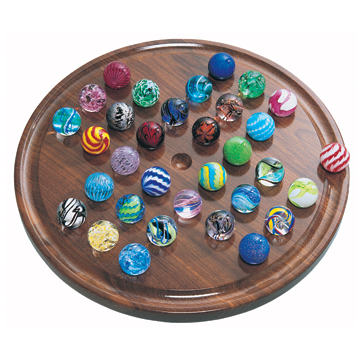|
Puss In The Corner
Puss in the Corner, also called Puss in Corner is a patience or solitaire card game that is played with a single pack of 52 playing cards. It is of the half-open, planner type and is a "thinly disguised variant of Sir Tommy," but with modifications and with the waste piles placed at the corners of the foundations, hence the name."Puss in Corner" (p.69) in ''The Little Book of Solitaire'', Running Press, 2002. It has the rare feature that the suits are built up in colour, not in suit. Rules The following rules conform to Parlett (1979) and Morehead (2001), except where stated. Set-up: First, the four aces are separated from the rest of the pack and placed side by side in two rows of two, forming a square. These are the foundations and the aim is to build on them in one colour and in sequence up to the kings. So diamonds and hearts may be built on one another, indiscriminately, and likewise, spades and clubs. Game-play: The player first turns the top card of the stock and determ ... [...More Info...] [...Related Items...] OR: [Wikipedia] [Google] [Baidu] |
Patience (game)
Patience (Europe), card solitaire or solitaire (US/Canada), is a genre of card games whose common feature is that the aim is to arrange the cards in some systematic order or, in a few cases, to pair them off in order to discard them. Most are intended for play by a single player, but there are also "excellent games of patience for two or more players". Name 'Patience' is the earliest recorded name for this type of card game in both British and American sources. The word is French in origin, these games being "regarded as an exercise in patience." Although the name solitaire became common in North America for this type of game during the 20th century, British games scholar David Parlett notes that there are good reasons for preferring the name 'patience'. Firstly, a patience is a card game, whereas a solitaire is any one-player game, including those played with dominoes or peg and board games. Secondly, any game of patience may be played competitively by two or more players. Am ... [...More Info...] [...Related Items...] OR: [Wikipedia] [Google] [Baidu] |
Solitaire
Solitaire is any tabletop game which one can play by oneself, usually with cards, but also with dominoes. The term "solitaire" is also used for single-player games of concentration and skill using a set layout tiles, pegs or stones. These games include peg solitaire and mahjong solitaire. The game is most often played by one person, but can incorporate others. History The origins of Card Solitaire or Patience are unclear, but the earliest records appear in the late 1700s across northern Europe and Scandinavia. The term ''Patiencespiel'' appears in ''Das neue Königliche L’Hombre-Spiel'', a German book published in 1788. Books were also reported to appear in Sweden and Russia in the early 1800s. There are additional references to Patience in French literature. In the United States, the first card solitaire book, ''Patience: A series of thirty games with cards'', was published by Ednah Cheney in 1870. The most popular card solitaire is Klondike, which was called Microsoft So ... [...More Info...] [...Related Items...] OR: [Wikipedia] [Google] [Baidu] |
Card Game
A card game is any game using playing cards as the primary device with which the game is played, be they traditional or game-specific. Countless card games exist, including families of related games (such as poker). A small number of card games played with traditional decks have formally standardized rules with international tournaments being held, but most are folk games whose rules vary by region, culture, and person. Traditional card games are played with a ''deck'' or ''pack'' of playing cards which are identical in size and shape. Each card has two sides, the ''face'' and the ''back''. Normally the backs of the cards are indistinguishable. The faces of the cards may all be unique, or there can be duplicates. The composition of a deck is known to each player. In some cases several decks are shuffled together to form a single ''pack'' or ''shoe''. Modern card games usually have bespoke decks, often with a vast amount of cards, and can include number or action cards. This ... [...More Info...] [...Related Items...] OR: [Wikipedia] [Google] [Baidu] |
Playing Card
A playing card is a piece of specially prepared card stock, heavy paper, thin cardboard, plastic-coated paper, cotton-paper blend, or thin plastic that is marked with distinguishing motifs. Often the front (face) and back of each card has a finish to make handling easier. They are most commonly used for playing card games, and are also used in magic tricks, cardistry, card throwing, and card houses; cards may also be collected. Some patterns of Tarot playing card are also used for divination, although bespoke cards for this use are more common. Playing cards are typically palm-sized for convenient handling, and usually are sold together in a set as a deck of cards or pack of cards. The most common type of playing card in the West is the French-suited, standard 52-card pack, of which the most widespread design is the English pattern, followed by the Belgian-Genoese pattern. However, many countries use other, traditional types of playing card, including those that are German ... [...More Info...] [...Related Items...] OR: [Wikipedia] [Google] [Baidu] |
Sir Tommy
Sir Tommy, also called Old Patience, is a patience or solitaire card game using a single pack of 52 playing cards. It is said to be the ancestor of all patiences, hence its alternative title. It is a half-open, planner type of patience game in the same family of card-building games as Calculation and Strategy. It is also known as Try Again and Numerica. Rules Cards are dealt one at a time. When an ace turns up, it forms a foundation which builds up to King regardless of suit. Four such foundations should be built. A card that cannot yet be placed on the foundation is placed onto one of four wastepiles; once placed, it cannot be moved, but the top card of each wastepile remains available to be placed on a foundation. The game is won if all cards are emptied from the wastepiles and built on the foundations. Strategy To achieve a win, skilled players typically reserve one wastepile for Kings and for other high cards, and trying to avoid trapping a lower-ranked card under all four ... [...More Info...] [...Related Items...] OR: [Wikipedia] [Google] [Baidu] |
The Prisoner Of Zenda (1937 Film)
''The Prisoner of Zenda'' is a 1937 American black-and-white adventure film based on Anthony Hope's 1894 novel of the same name and the 1896 play. A lookalike has to step in when his royal distant relative is kidnapped to prevent his coronation. This version is widely considered the best of the many film adaptations of the novel and play. The film stars Ronald Colman, Madeleine Carroll and Douglas Fairbanks Jr., with a supporting cast including C. Aubrey Smith, Raymond Massey, Mary Astor and David Niven. It was directed by John Cromwell, produced by David O. Selznick for Selznick International Pictures and distributed by United Artists. The screenplay was written by John L. Balderston, adapted by Wells Root from the novel, with dramatization by Edward Rose; Donald Ogden Stewart was responsible for additional dialogue and Ben Hecht and Sidney Howard made uncredited contributions. Alfred Newman received the first of his 43 Academy Award nominations, for Original Music Score, ... [...More Info...] [...Related Items...] OR: [Wikipedia] [Google] [Baidu] |
Douglas Fairbanks Jr
Douglas Elton Fairbanks Jr., (December 9, 1909 – May 7, 2000) was an American actor, producer and decorated naval officer of World War II. He is best known for starring in such films as ''The Prisoner of Zenda'' (1937), ''Gunga Din'' (1939) and '' The Corsican Brothers'' (1941). The son of Douglas Fairbanks and stepson of Mary Pickford, he was first married, briefly, to actress Joan Crawford. Early life Douglas Elton Fairbanks Jr. was born in New York City; he was the only child of actor Douglas Fairbanks and his first wife, Anna Beth Sully, the daughter of wealthy industrialist Daniel J. Sully. Fairbanks' father was one of cinema's first icons, noted for such swashbuckling adventure films as '' The Mark of Zorro'', ''Robin Hood'' and '' The Thief of Bagdad''. Fairbanks had small roles in his father's films '' American Aristocracy'' (1916) and ''The Three Musketeers'' (1921). His parents divorced when he was nine years old, and both remarried. He lived with his mother i ... [...More Info...] [...Related Items...] OR: [Wikipedia] [Google] [Baidu] |
Ronald Colman
Ronald Charles Colman (9 February 1891 – 19 May 1958) was an English-born actor, starting his career in theatre and silent film in his native country, then immigrating to the United States and having a successful Hollywood film career. He was most popular during the 1920s, 1930s and 1940s. He received Oscar nominations for ''Bulldog Drummond'' (1929), ''Condemned'' (1929) and ''Random Harvest'' (1942). Colman starred in several classic films, including ''A Tale of Two Cities'' (1935), ''Lost Horizon'' (1937) and ''The Prisoner of Zenda'' (1937). He also played the starring role in the Technicolor classic '' Kismet'' (1944), with Marlene Dietrich, which was nominated for four Academy Awards. In 1947, he won an Academy Award for Best Actor and Golden Globe Award for Best Actor for the film '' A Double Life''. Colman was an inaugural recipient of a star on the Hollywood Walk of Fame for his work in motion pictures. He was awarded a second star for his television work. Early ye ... [...More Info...] [...Related Items...] OR: [Wikipedia] [Google] [Baidu] |
List Of Solitaires
This is a list of patiences, which are card games that are also referred to as solitaires or as card solitaire. This list is not intended to be exhaustive, but only includes games that have met the usual Wikipedia requirements (e.g. notability). Additions should only be made if there is an existing entry on Wikipedia that they can be linked to. To avoid duplicate pages being created, alternative titles and the names of variants are listed separately (except titles that include little more than the name of the parent game). Games of the patience genre played by more than one player are marked with a plus (+) sign. A * Accordion * Aces and Kings * Aces Square * Aces Up * Acme * Addiction * Agnes * Alaska * Algerian * Alhambra * Amazons * American Toad * Apophis * Appreciate * Acquaintance * Archway * Auld Lang Syne * Australian Patience B * Babette * Backbone * Baker's Dozen * Baker's Game * Baroness * Batsford * Beetle * Beleaguered Castle * Belvedere * ... [...More Info...] [...Related Items...] OR: [Wikipedia] [Google] [Baidu] |
Glossary Of Solitaire Terms
Games of patience, or (card) solitaires as they are usually called in North America, have their own 'language' of specialised terms such as "building down", "packing", "foundations", "talon" and "tableau". Once learnt they are helpful in describing, succinctly and accurately, how the games are played. Patience games are usually for a single player, although a small number have been designed for two and, in rare cases, three or even four players. They are games of skill or chance or a combination of the two. There are three classes of patience grouped by object. The most frequent object is to arrange the cards either in ascending sequence (e.g. from Ace to King) or descending sequence. Occasionally both forms of sequence are aimed at in the same game. The card forming the starting point of the required sequence is known as the foundation card and the sequence or family is said to be 'built up' on such card. In some cases foundation cards are picked out and placed in position ... [...More Info...] [...Related Items...] OR: [Wikipedia] [Google] [Baidu] |





